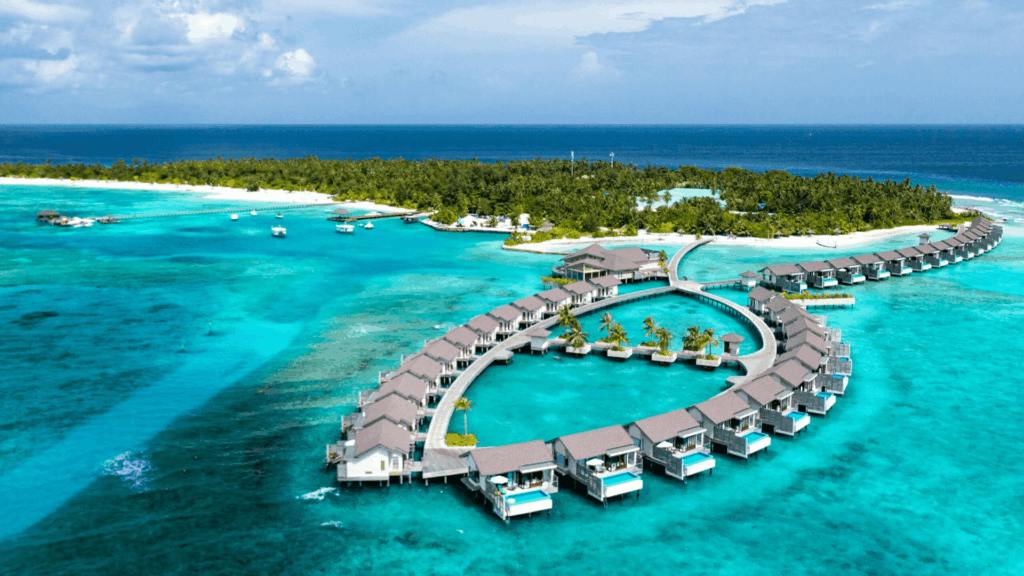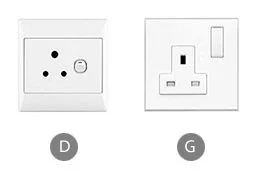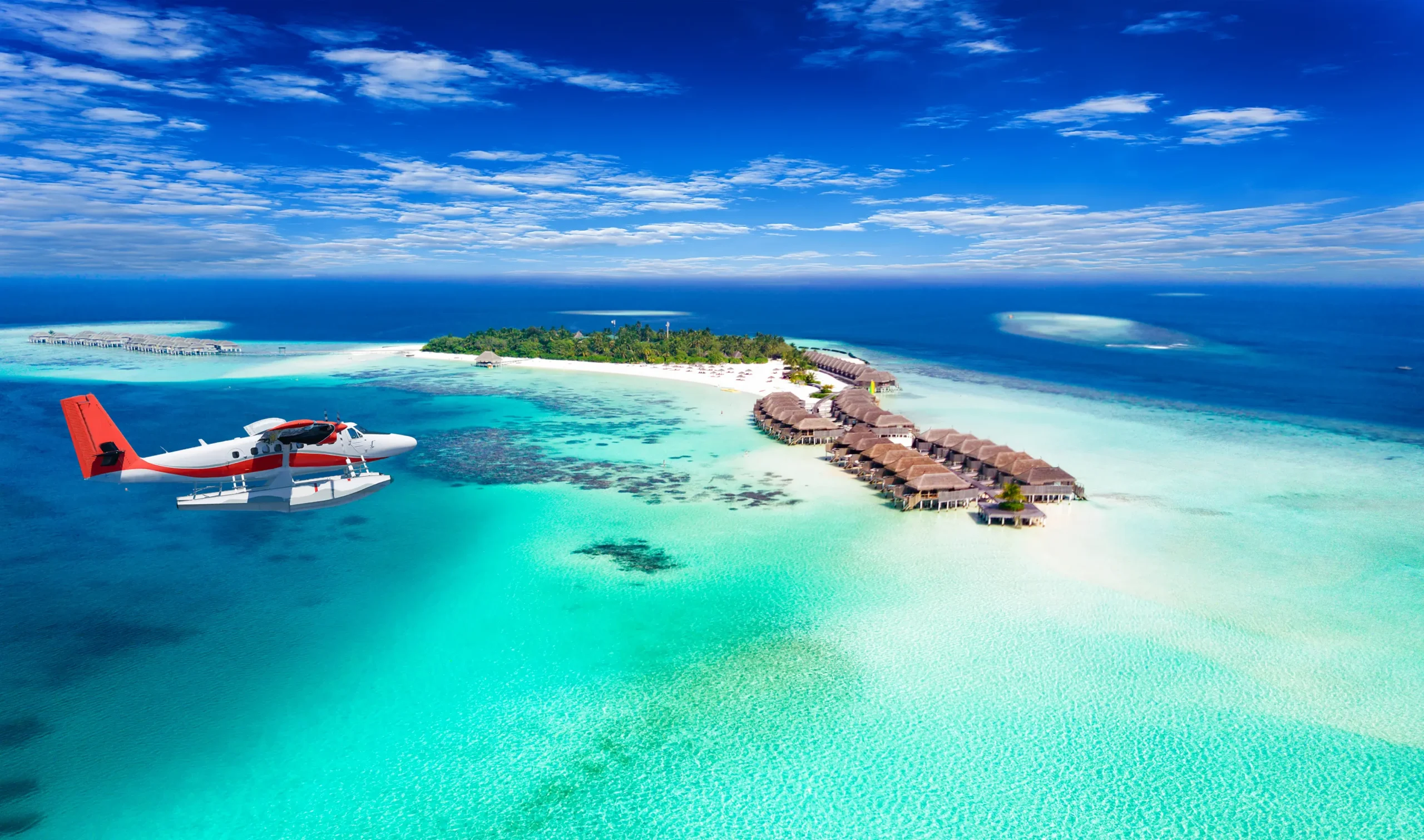Plan Your Visit
A true tropical paradise, the Maldives stretch across more than 1,000 coral islands scattered in the Indian Ocean. Each island is compact enough to explore on foot or by bicycle, enhancing the serene island vibe. Getting around is part of the charm—yachts, speedboats, traditional dhonis, and scenic seaplane rides make island-hopping an unforgettable experience.
But the Maldives are more than just a luxury retreat. With top-tier resorts, iconic overwater villas, and private island escapes, they promise indulgence. Adventure lovers can dive into vibrant coral reefs, snorkel alongside exotic marine life, or enjoy kayaking, paddleboarding, and jet skiing. Wildlife experiences like dolphin cruises and whale watching add even more wonder. The Maldives also blend culture and nature, offering unique eco-tourism and heritage encounters.
Whether you’re planning a romantic honeymoon, craving luxury, chasing thrilling water sports, focusing on wellness, or traveling with family—this guide covers everything you need to know for an unforgettable Maldives getaway.

Currency
Maldivian Rufiyaa (MVR) is the official currency of the Maldives. However, due to high tourism, US dollars are also commonly accepted and are one of the most easily exchanged currencies. MVR can be obtained at airports, banks, and select resorts. While cash is accepted, Visa, MasterCard, and American Express are widely used at major resorts and hotels.
If you’re relying on ATMs, keep in mind they are not available on every island, nor at all accommodations. ATMs are mostly located in Malé, the capital, and typically dispense Rufiyaa.
Important Tip
Notify your bank of your travel plans to avoid international card blocks.
Many resorts use cashless systems, allowing guests to charge all expenses to their room and pay at checkout. On smaller or local islands, cash—preferably in MVR—is often required.
While tipping is not compulsory, it’s always welcomed. And yes, USD is accepted in most places for added convenience.
Power Outlets & Mobile Connectivity in the Maldives
You can purchase prepaid SIM cards from local providers Dhiraagu and Ooredoo, both available at Malé International Airport. These SIM cards offer around 90% coverage, even across many remote islands.

Maldivian hotels typically offer four different socket types, with Type D and Type G being the most commonly used.
The standard voltage is 230V, with a frequency of 50 Hz.
If you’re traveling with Type C, L, or other plug types, it’s recommended to bring a universal travel adapter to ensure compatibility.
Climate and seasons
The Maldives enjoys a tropical monsoon climate, offering warm temperatures year-round and two distinct seasonal patterns: dry and wet. With average daytime temperatures around 30°C (86°F) and ocean temperatures between 26°C and 29°C (79°F–84°F), the islands provide a consistently sunny and pleasant environment.
The Maldives experiences two main seasons:
1. Dry Season (Northeast Monsoon):
Occurs from January to March
Known for clear skies and minimal rainfall
Perfect for beach days, water sports, and outdoor exploration
2. Wet Season (Southwest Monsoon):
Runs from mid-May to November
Brings higher humidity and occasional rainfall
Great for travelers seeking a lush, tropical atmosphere
While it’s called the “wet season,” rain typically comes in short, localized bursts rather than all-day showers. These are often quick tropical downpours followed by sunshine. Even with brief storms—most commonly during the southwest monsoon—the Maldives remains a popular, year-round destination.
Keep in mind that climate change may affect seasonal norms, leading to unexpected weather variations in some years. Nonetheless, the Maldives continues to offer a warm, inviting climate for travelers at any time.
Getting Around the Islands
Most Maldivian islands are small enough to explore on foot or by bicycle, which is why you won’t find car rental services here. Still, transportation between islands is well-developed, offering several ways to travel when needed.
IMPORTANT: Inter-island transfers can be costly, so it’s best to plan your itinerary in advance to avoid unexpected travel expenses.
For island hopping, travelers can choose from a range of options — seaplanes for long distances, yachts, water taxis, ferries, and traditional wooden Dhonis, all offering unique ways to explore the Maldives.

Air Travel
With over 1,000 islands, the Maldives depends heavily on air transport for both international arrivals and domestic connections. Velana International Airport, located on Hulhulé Island near Malé, is the main hub for international travelers and domestic transfers.
Due to the scattered geography, domestic flights play a crucial role. The national airline, Maldivian, links over a dozen regional airports, making remote islands accessible. These inter-island flights—often operated by seaplanes or small aircraft—offer stunning aerial views of turquoise waters and coral-ringed islets.
Seaplane
Seaplanes offer a scenic and efficient way to reach even the most remote island resorts within 90 minutes from Malé. Flying at low altitudes, they provide panoramic views of reefs and lagoons. Prices typically range from MVR 3,500 to MVR 7,000. Note: they operate only during daylight hours, and luggage may follow different handling rules.
Speedboat
For quick island transfers, speedboats are a popular and flexible choice. Though more expensive than ferries (fares can reach MVR 3,500), they provide a direct link between airports, resorts, and inhabited islands. Many resorts offer pre-arranged speedboat transfers, or travelers can book independently.
Ferry
Public ferries run by the Maldives Transport and Contracting Company (MTCC) serve local islands and budget-conscious travelers. Fares range from MVR 30 to MVR 75 for trips up to five hours, with the Malé airport ferry priced around MVR 40. While economical, these ferries don’t run on Fridays, typically operate between 6:00 AM to 6:00 PM, and do not serve resort islands. Still, they offer a glimpse into local Maldivian life.
Maldivian ‘Dhoni’
The dhoni is a traditional Maldivian wooden boat with roots in Arab dhow design. Once used for fishing and cargo, it now plays a role in tourism. Many resorts offer dhoni trips for scenic tours or romantic sunset cruises. Day rentals usually range from MVR 1,000 to MVR 1,500. Dhonis are commonly seen at docks, including Malé’s eastern harbor near Boduthakurufaanu Magu.
Yacht
For the ultimate in comfort, private yachts offer a luxurious way to explore the Maldives. Whether chartering or bringing your own vessel, yachts provide access to remote islands and personalized itineraries. Rates vary based on size, features, and services. A three-cabin yacht for six guests may cost around MVR 55,000 per day, making it a premium way to experience the islands.
Culture and tradition
The Maldives is a predominantly Sunni Muslim country. The national language, Dhivehi, shares linguistic roots with Sri Lankan Sinhala. Maldivians have built a rich, unique culture shaped by the sea and influenced by Indian, Arab, African, and Sri Lankan heritage. This cultural fusion has evolved into a proud national identity that stands resilient amid modernization and growing tourism.
The ocean plays a vital role in everyday life, inspiring everything from fishing and boat craftsmanship to music, cuisine, and art. These influences appear throughout Maldivian folklore and traditions, often with strong maritime themes.
Language: Dhivehi is rooted in Sanskrit but has developed distinct characteristics unique to the Maldives.
Religion: Islam, introduced in the 12th century, is practiced in a culturally adapted, moderate form.
Arts & Crafts: Handicrafts like lacquer work and mat weaving highlight both heritage and outside influence.
Music & Dance: Traditional Bodu Beru drum performances mix African beats with local music styles.
Cuisine: Blending South Asian and Arab flavors, local dishes emphasize fish, coconut, and starches.
Social Structure: The Maldives maintains a more egalitarian society than many nearby countries, shaped by its island-based way of life.
If you’re visiting Malé or other inhabited islands, remember that alcohol is prohibited in these areas. While Malé is open to tourists, we strongly recommend checking your foreign ministry’s travel advisories before exploring beyond major resort zones.
Food, Drink & Tobacco in the Maldives
As a Muslim country, the Maldives primarily offers non-alcoholic beverages. Popular choices include fresh coconut water, tropical fruit juices, and tea. A traditional local drink called Raa, made from fermented palm sap, is non-alcoholic.
Note: Alcohol is available only on resort islands. If you’re staying on a local inhabited island, you won’t be able to purchase or consume alcohol. Resorts, however, offer a wide selection of imported wines, beers, and spirits for international guests.
Seafood is a key highlight of Maldivian cuisine. Fresh fish is served grilled, fried, or curried, alongside other marine specialties like lobster, octopus, and squid. Tropical fruits such as papaya, pineapple, and mango add sweetness to meals, while vegetables like pumpkin, eggplant, and sweet potato are commonly used.
Most resorts cater to various dietary preferences, including vegetarian, vegan, and halal options.
The Maldives’ culinary landscape differs greatly between luxury resorts and local islands. Resorts serve both international and Maldivian cuisine, with some even featuring underwater dining experiences. On local islands, small eateries offer authentic local meals for a more genuine cultural experience.
Tobacco is legal but tightly regulated in the Maldives. Smoking is banned in many public areas, such as schools, hospitals, and government buildings. Many resorts have designated smoking areas for guests.
In tourist zones, outdoor smoking is typically allowed in marked areas, though rules may vary depending on the property. On local islands, stricter norms may apply due to cultural sensitivities.
Visitors are allowed to bring a limited personal supply—up to 200 cigarettes or 250g of tobacco products per person. However, if you plan to buy cigarettes locally, be aware that they are heavily taxed and relatively expensive.
Vaping and e-cigarettes are only permitted where smoking is allowed. Bring your own, as they are not sold locally. The same rules generally apply to shisha/hookah products.
Maldives’ Must-See Places and Activities
Cultural Tours
Explore the capital, Malé:
Sample local cuisine at the Malé Market
Visit the beautiful Hukuru Miskiy Mosque and Grand Friday Mosque
Stop by the National Museum (open SUN–THU, 08:00–18:00)
Stroll through Sultan Park
Check out the Malé Fish Market
Water Adventures
Take a 45-minute submarine ride beneath the waves
Join an 8-day island-hopping adventure
Explore Maafushi Island, Vaavu Atoll, and South Malé on a 5-day tour
Beaches to Visit
Veligandu Island Beach (North Ari Atoll): Often ranked as the Maldives’ most stunning beach
Fulhadhoo Beach (Baa Atoll): A quieter, more secluded spot
Hulhumale Beach (near Malé): Popular for its size and water sports offerings
Bikini Beach (Rasdhoo Island): One of the few public beaches where bikini attire is permitted
Sun Island Beach (South Ari Atoll): Known for fantastic snorkeling
Mirihi Island Beach (South Ari Atoll): Ideal for spotting whale sharks
Mudhdoo Beach (Dusit Thani): Famous for its glowing bioluminescent shoreline
Note: Many beaches are exclusive to specific resorts and may require booking a stay at the respective resort to access them.
Beach Dress Code in the Maldives
On resort islands, the dress code is relaxed. Bikinis, swimsuits, and typical beachwear are welcome.
However, high-end resorts may require more modest or formal attire for restaurants and evening venues.
On public beaches, modest clothing is expected.
Women: T-shirts with shorts or skirts that cover the knees
Men: Shirts with swim trunks or shorts
Full-body swimwear such as burkinis is allowed
Some local islands have designated “Bikini Beaches”, where Western-style swimwear is permitted. These areas are clearly marked and kept separate from public beaches where modest dress is required.
When taking part in snorkeling or other water activities, standard swimwear is usually accepted—even on local islands. Still, it’s a good practice to cover up while walking between the beach and your accommodation.
General Etiquette Tips:
Dress modestly outside of resorts or official tourist beaches to respect local customs
Nudity and topless sunbathing are illegal in the Maldives
When visiting mosques or religious sites, wear conservative attire; women should also cover their heads
Plan Ahead for Your Maldives Adventure
Time Zone
The Maldives follows Maldives Standard Time (MVT) – UTC+5 – and does not use daylight saving time. Time differences include:
+5 hours ahead of London in winter (+4 in summer)
+9 hours ahead of Sydney
+10 hours ahead of New York
+1 hour ahead of Dubai
Good to Know: Most government offices and businesses on inhabited islands operate Sunday through Thursday, in line with the Islamic workweek.
Entry Requirements
Submit an IMUGA Traveller Declaration before your arrival
Passport must be valid for at least 6 months and contain a Machine Readable Zone (MRZ)
Present your complete travel itinerary, including return tickets and proof of full accommodation
Best Time to Visit the Maldives
Peak Season (December – March): The driest period with the best diving/snorkeling conditions
Shoulder Season (April–May & October–November): Fewer crowds, decent weather, and better rates
New Year & Christmas: Very popular but expensive—book far in advance
Currency & ATMs
Rufiyaa (MVR) is the official local currency
ATMs are limited, mostly found in Malé, the airport, and major resorts—carry MVRs for remote islands
USD is widely accepted, especially in tourist zones
Dress Code
When visiting local islands or historical/religious sites, dress modestly:
Avoid tight or see-through clothing
Men should wear knee-length shorts and shirts
Women should wear loose-fitting clothes covering shoulders and knees
In mosques, women must cover their head and wear long sleeves and full-length skirts or trousers
Outside tourist beaches, bikinis are not allowed unless clearly stated.
Use a sarong or beach cover-up when leaving the shore, and men should keep shirts on when not swimming.
Items You Can Bring into the Maldives
Tobacco: Tourists are permitted to bring up to 250g of tobacco, 25 cigars, or 200 cigarettes.
Medication: Allowed with a valid prescription. The supply must match the length of your stay.
Pets: Permitted only with an official health certificate from a licensed veterinarian.
Items Prohibited from Entry
Firearms, alcohol, pork, idols of worship, and pornographic material are strictly forbidden.
Bringing illegal drugs is a serious offense and carries severe penalties.
IMUGA Travel Permit for the Maldives
IMUGA (Maldives Electronic Traveller Declaration) is a mandatory travel document for all foreign visitors. It must be completed online within 96 hours (4 days) prior to arrival in the Maldives.
Travelers are required to submit:
Personal Information: Full name, country of residence, email, and phone number
Travel Details: Mode of travel, arrival date, departure point, port of entry, flight or cruise info, and booking reference (PNR)
Accommodation Info: Hotel/resort name, location, length of stay, and next destination after departure
